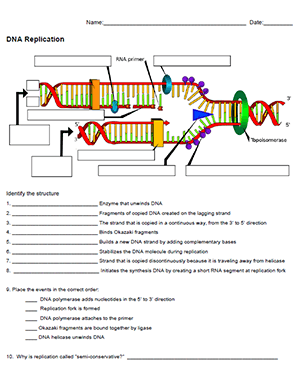
For freshman, DNA replication is only covered in basic terms, where students are told that the process is semi-conservative and leads to the production of two new identical strands.
AP Biology students are required to learn te steps of DNA replication and the roles that enzymes like DNA polymerase, helicase, and ligase, play in the process. They must grapple with the concept that the two sides are not copied in the same way. This is due to the fact that DNA polymerase can only travel in the 3′ to 5′ direction.
This means that one side, the leading strand is copied continuously, while the lagging strand is copied discontinuously and creates Okazaki fragments that must be bound together later.
This worksheet was designed for students to help them learn or study the steps in involved in DNA replication and the enzymes needed for the process.
This document could also be used for assessments, though the focus is mainly the steps and vocabulary associated with replication. The image was created from a Wikipedia Image of Replication where I added boxes for labeling. I made two versions, one with a word bank and one without a wordbank.
Grade Level: 10-12
Time Required: 10-15 minutes
HS-LS1-1 Construct an explanation based on evidence for how the structure of DNA determines the structure of proteins which carry out the essential functions of life through systems of specialized cells.
HS-LS3-2 Make and defend a claim based on evidence that inheritable genetic variations may result from: (1) new genetic combinations through meiosis, (2) viable errors occurring during replication, and/or (3) mutations caused by environmental factors.

